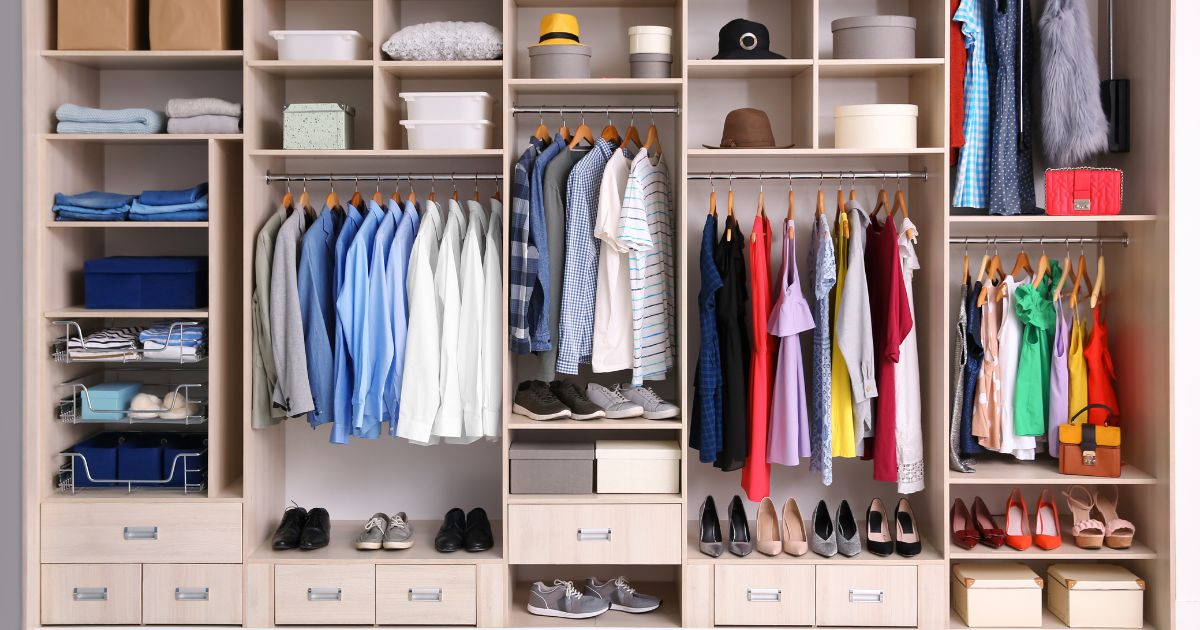Are you overwhelmed by a messy, disorganized closet and unsure where to start decluttering? While taking inspiration from Mari Kondo’s approach, this article will focus on how to declutter closet, answering questions like which clothes to remove, and what to purge, and offering five tips for organizing your space. Let’s dive into transforming your closet into a functional and clutter-free haven.
Preparing for the Decluttering Process
Get in the Right Mindset
To prepare yourself mentally for the task ahead, consider the following:
Remind yourself of the benefits
Decluttering will create a more organized and efficient wardrobe, making it easier to find items and put outfits together.
Practice gratitude
Recognize and appreciate the items you’ve enjoyed using and the memories associated with them, even if it’s time to let them go.
Visualize the end result
Imagine a clean, organized space that brings you joy and makes getting dressed a breeze.
Accept that it will take time and effort
Beat in mind that when you declutter your closet, the process will take time and effort. Apart from physically sorting through your clothes, there’s an effort in choosing which pieces will be kept and removed.
Schedule and Commit to a Time
To schedule enough time for the decluttering process, consider the following:
Be realistic about your time
Determine how long it might take based on the size of your closet and the number of items you have.
Break it into smaller tasks
If you can’t allocate a full day, break the process down into smaller tasks you can tackle over several days or weeks.
Clear your schedule
Remove or reschedule other commitments to ensure you have enough time to focus on decluttering.
Set a deadline
Giving yourself a specific end date can help you stay focused and motivated.
Gather Supplies
Gather the necessary supplies for a successful decluttering process, including
Trash bags
Large, sturdy bags for throwing away items that are damaged, stained, or too worn.
Donation boxes
Separate boxes for items that are in good condition but no longer needed. Consider labeling them for different organizations, such as charities, consignment shops, or clothing swaps.
Storage containers
Clear plastic bins, drawer dividers, and other organizers to help you store and categorize your items neatly.
Labels and markers
Label your storage containers to make it easier to find items and keep your closet organized.
A full-length mirror
To try on items and make informed decisions about what to keep, donate, or discard.
A notepad and pen
To jot down notes about items you need to replace or gaps in your wardrobe that you’d like to fill.
A camera or smartphone
To document your progress, take before-and-after photos, or create a digital inventory of your wardrobe.
Decluttering Your Closet
Empty Your Closet
Begin by removing everything from your closet, including clothes, shoes, and accessories. This will give you a clean slate and a clear view of the space you’re working with. It’s also an opportunity to clean your closet by dusting shelves, wiping down surfaces, and vacuuming or sweeping the floor. Starting with a clean and organized space will make it easier to maintain order in the future.
Sort by Category
Organize your clothes into categories, such as tops, bottoms, dresses, outerwear, shoes, and accessories. Within each category, further sort items by subcategories like casual, formal, and seasonal wear. This will help you better assess the volume of items you have, identify duplicates, and make it easier to declutter. It’s also a great way to discover forgotten items you may want to incorporate back into your wardrobe.
Assess Each Item
As Mari Kondo suggests, hold each item and ask yourself if it brings joy or if it’s still functional. Consider the item’s condition, how often you wear it, and whether it fits well. If the answer is no, it’s time to let it go. You can also use the “one-year rule” – if you haven’t worn it in the past year, it’s time to part with it.
Donate, Sell, or Recycle
Separate unwanted items into piles for donation, selling, or recycling. Be responsible and environmentally friendly when disposing of your clothing. For donation, choose local charities, shelters, or thrift stores that can benefit from your gently used items. For selling, consider using online platforms like Poshmark, eBay, or local consignment shops. Finally, for recycling, look for textile recycling programs or facilities in your area that accept damaged or unwearable clothing.
Organizing Your Closet
Use Appropriate Hangers
Invest in slim, non-slip hangers that save space and keep your clothes securely in place. Opt for velvet hangers for delicate items, wooden hangers for suits and heavy coats, and padded hangers for knitwear to prevent stretching or damage. Avoid using wire hangers, as they can cause creasing and misshapen shoulders.
Organize by Color or Type
Arrange your clothes by color or type, making it easier to find items and creating an aesthetically pleasing closet. Organizing by color allows you to quickly locate specific pieces and can inspire new outfit combinations. Organizing by type (casual, formal, work, etc.) can also be helpful if you have a diverse wardrobe, as it keeps similar items together for easy selection.
Utilize Storage Solutions
Use shelf dividers, storage boxes, and bins to keep different categories of items organized and accessible. For example, use clear plastic bins for shoes, drawer dividers for socks and undergarments, and shelf dividers for folded clothes like sweaters and jeans. Additionally, consider installing hooks or a pegboard for hanging accessories like belts, scarves, and hats.
Store Seasonal Items
Keep out-of-season clothing in labeled bins or under-the-bed storage, freeing up valuable closet space. Rotate your wardrobe as the seasons change, making sure to properly clean and store items before putting them away. Vacuum-sealed bags can be used for bulky items like winter coats and blankets to save even more space.
Maintain Visibility
Ensure all items are easily visible and accessible to prevent clutter from building up again. Use open shelving and clear storage containers to see the contents at a glance. Place frequently worn items at eye level and less-used items on higher shelves or toward the back of your closet. Regularly assess your closet and adjust the organization as needed to maintain visibility and accessibility.
Keeping Your Closet Clutter-Free
Implement the “One In, One Out” Rule
For every new item you bring into your closet, remove one to maintain balance and prevent overcrowding. This rule helps you stay mindful of the items you already own and encourages thoughtful purchasing. For example, if you buy a new pair of jeans, donate or sell an older pair that you no longer wear. This practice ensures your closet remains organized and makes it easier to maintain a clutter-free space.
Schedule Regular Decluttering Sessions
Every few months or at the start of each season, set aside time to declutter your closet, keeping it tidy and functional. Regularly assessing your wardrobe allows you to identify items that no longer bring joy or serve a purpose. By routinely removing unwanted items, you make room for new purchases and keep your closet organized. Consider setting a calendar reminder to establish a consistent decluttering schedule.
Monitor Your Shopping Habits
Be mindful of your purchases and only buy items that truly bring joy or serve a purpose in your wardrobe. Avoid impulsive shopping by creating a list of wardrobe essentials or items you genuinely need. Before buying something new, consider its versatility, quality, and how well it fits with your existing wardrobe. By being more conscious of your shopping habits, you can minimize clutter and make better use of the items you already own.
Additional Tips on How to Declutter Closet:
- Establish a designated space in your closet for new items, so you know when it’s getting full and need to declutter.
- Create a wardrobe budget to control spending and prioritize quality over quantity.
- Practice the 30-day rule: if you see something you want to buy, wait 30 days before purchasing it. If you still want it after 30 days, it’s more likely to be a valuable addition to your wardrobe.
- Regularly reorganize your closet to maintain optimal functionality, adjusting the layout as needed based on the season, new additions, or changes in your lifestyle.
- Share or swap clothes with friends or family members to refresh your wardrobe without adding clutter. Participate in clothing swaps or host your own to exchange items with others and discover new pieces you’ll love.
The Importance of Decluttering for Maintaining Closet Quality and Materials
Prevents Damage to Clothing and Materials
A cluttered closet can lead to wrinkling, creasing, and stretching of your clothes as they become compressed and entangled. Decluttering helps maintain the quality of your garments by providing adequate space and proper storage solutions, ensuring items are hung or folded correctly and protected from damage.
Promotes Air Circulation
A well-organized and decluttered closet promotes better air circulation, which helps prevent the growth of mold and mildew on your clothing and closet materials. This is particularly important for wooden or fabric-lined closets, which can be susceptible to moisture-related damage. Adequate airflow also helps to keep your clothes smelling fresh and reduces the likelihood of musty odors.
Reduces Wear and Tear on Closet Structures
An overcrowded closet can put excessive weight on shelves, hanging rods, and other closet structures, leading to potential sagging, bending, or even breaking. By decluttering and properly distributing the weight of your items, you can maintain the integrity and longevity of your closet’s structural elements.
Simplifies Cleaning and Maintenance
A clutter-free closet is easier to clean and maintain, as there’s more space to access shelves, rods, and other surfaces. Regular cleaning of your closet prevents the buildup of dust, dirt, and allergens, helping to preserve the materials of both your closet and your clothing.
Increases Visibility and Accessibility
If you know how to declutter closet, you can easily see and access all of your items, reducing the need to rummage through piles of clothes or push garments aside. This not only helps maintain the quality of your clothing but also protects the interior surfaces of your closet from scratches, dents, or other damage caused by frequent shuffling or friction.
Conclusion
Learning how to declutter closet and maintain a tidy wardrobe is a skill that can positively impact your daily life. By following this step-by-step guide, drawing some inspiration from Mari Kondo’s method, and staying consistent with organization, you can enjoy a functional, clutter-free closet.

